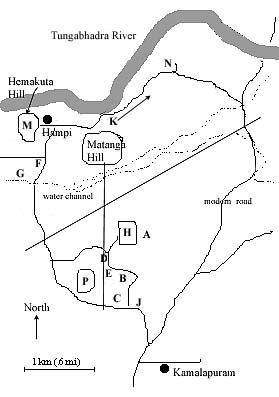
|
Vijayanagara
A - Elephant Stables
(1),
B - Great Platform (Mahanavami-dibba)
(8)
C - Great Tank
(2),
Stepped Tank
(3),
D - Hazara Rama Temple (Ramachandra)
(8),
E - Hundred-Columned Hall,
(2),
F - Krishna Temple
(6),
G - Linga Shrine
(1),
Narasimha Monolith
(2),
H - Lotus Mahal
(5),
J - Queen's Bath
(2),
K - River Walk
(8),
M - Virupaksha Temple
(8),
Hemakuta Hill
(5),
N - Vitthala Temple
(19),
and - other features
(4)
|
Pronunciation: [VEE-jay-uh-NAHG-uh-ruh] (formal), or
[VIJH-uh-NAHG-ruh] (informal).
The royal site of Vijayanagara ("Victory City") in Karnataka,
is located
just south of the Tungabhadra river between Hampi and Kamalapuram.
Measuring approximately 5km by 5km, this was the capital of an
empire that during its greatest extent (King Krishna Devaraya,
1510-1529) ruled most
of southern India, from the uplands of the Deccan plateau to the southernmost tip of the Indian subcontinent.
This great Hindu empire, the successor of the
Hoysalas, was
founded in 1336 by two brothers - Harihara and Bukka Sangama - who
were sent to Hampi by the Delhi Sultanate to pacify that region. Rescinding their
allegiance to their former masters, the Sangamas established an
empire that blocked Muslim southward expansion until
1565, when a coalition of forces defeated the usurper king Ramaraja
and sacked the royal capital. The fatally weakened empire
eventually fragmented into a collection of independent
Nayaka kingdoms, ruled by their former Vijayanagara governors.
In addition to its historical importance, Vijayanagara is also a sacred site, the location of Hanuman's kingdom.
This legendary association, which extends to the identification of specific places mentioned in the Ramayana, was at the forefront of consciousness of the people who designed and constructed the city.
The Vijayanagara site is approximately a square, 5km on each side.
In the site plan, above, a diagonal line from southwest to northeast
divides the site into two areas, a "Sacred Center" (north) and a
"Royal Center" (south). In the Royal Center, a vertical line,
drawn due north from the
Hazara Rama Temple, intersects
the top of Matanga Hill. East of this line, are located the public and ceremonial spaces of the Vijayanagara
court, together with an enclosure (to the north and east) which
contains various Islamic-styled buildings (Lotus Mahal, elephant stables). West of the line
are private palaces and residences of the court.
For additional information:
Where Kings and Gods Meet, the site documentation report by John M. Fritz, George Michell, and M. S. Nagaraja Rao.
Vijayanagara Research Project web site by John M. Fritz and George Michell

